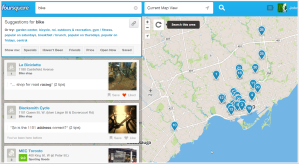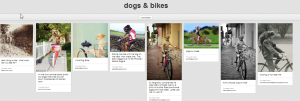I have just found the wonders of Foursquare – I am planning my vacation time in Toronto for the upcoming holiday season and will be posting and sharing where I plan to go and where I have been. I will be honest in my review of the locations. Please visit me on Foursquare

https://foursquare.com/john_diogenous
Category Archives: Uncategorized
#CycleON: Popular Opinion(s) Regarding Ontario’s New Cycling Strategy

English: Riders assemble for a ride organised by the London Cycling Campaign, as part of Bike Week activities. (Photo credit: Wikipedia)
Have you read the CycleOn proposal that is sweeping the cycling nation? This new proposal is aimed at positioning Ontario as an innovative, bike-friendly province before 2033. To say that CycleON contains “aspirational goals” might be the under- exaggeration of the year. The progressive nature of this proposal has created a lot of buzz around biking in Canada: Protestors and positive supporters have begun to share their insights across social media, in the press and offline at community events. Therefore, I wanted to write this blog to look at some of the issues that are being raised, as well I what #CycleON can offer to Ontario bikers.
For some background regarding the proposal, visit: http://www.mto.gov.on.ca/english/pubs/cycling/index.shtml. Here you can read the provincial proposal, as well as review background information such as the concepts/research behind the strategy. This background includes the acknowledgement of the positive environmental, communal and physiological impacts that growing the cycling population will inevitably have on Ontario. I am sure that every active cyclist can agree with this strategic thought process as cycling offers a powerful antidote to many of the issues that are preventing Ontarians from realizing more active lives that do not cause ecological harm.
While this strategy is positive and sensible, one issue that is being constantly communicated across on and offline media is that CycleON focuses on extremely lofty and, at times, unrealistic goals. The truth behind this accusation is not hard to see when you look at CycleON’s Strategic Directions. Arguably, it may be difficult for the masses to imagine how CycleON alone will, “Design Healthy, Active & Prosperous Communities.” Especially for non-cyclists, I can imagine that this proposal seems like quite the ideological reach.
However, if you do not get too caught up in the specifics, you can see that the Ministry has a very positive and altruistic aim of creating more physically able and happier communities. Biking may not be the only solution, but by positioning it as an absolute stronghold in the fight for vitality, the Ministry will force communities to re-evaluate the indispensable nature of cycling.
Personally, I would love to see many of the CycleON objectives come true. We have 20 years to transform our province and, I believe, that it can happen. CycleON bring attention to the fact that not even one Ontario city is currently acknowledged in the top 100 bike-friendly cities. With a bold aim of getting us in the top ten, CycleON demonstrates that they have big goals for bikes.
Unfortunately, this and some of the other more “reaching” aspects of the plan are bringing sceptics out of the woodwork. I just hope that they do not disregard the positive nature of the entire plan in favour of a pessimistic refusal of progression. Luckily, passionate cyclists who have been consistently disappointed by conditions in Ontario are rallying behind the new doctrine.
If CycleON’s goals were not big and bold then there would be nothing to strive for. We need a huge push behind our motorists to ensure that the celebration of cycling becomes a widespread phenomenon. I have often spoken to the cyclist/motorist dichotomy that seems to inhibit the widespread acceptance of bike lanes/safety precautions. I hope that CycleON will remedy some of this built-up tension and reposition Ontario as a province that is more friendly toward non-motorized transportation. If Ontario commits to reaching even some of the CycleON goals, then I truly believe that we will all be living in a happier and healthier community.
Related articles
- Are Toronto Bikers Finally Being Heard? (johndiogenous.wordpress.com)
- What the Bike Community is Saying About Cycling Collisions (johndiogenous.wordpress.com)
- A start for Ontario’s cycling strategy that is streets behind (theglobeandmail.com)
- Ontario Trails News – OK it’s about road cycling, but bikes and riders also use Ontario Trails! (ontariotrails.blogspot.com)
New Photos
Please visit my flickr account for new photos
Bicycle Bashing or Concerned Citizens About Cycling Safety?
Bicycle Bashing or Concerned Citizens About Cycling Safety?
New Blog post on the safety of cyling in Toronto
Win a VIP Trip to the 2014 Bridgestone NHL Winter Classic
Win a VIP Trip to the 2014 Bridgestone NHL Winter Classic. Enter the 2014 Bridgestone NHL Winter Classic, courtesy of NHL Network. The Detroit Red Wings will host the Toronto Maple Leafs on January 1, 2014 at The Big House in Ann Arbor Michigan. Enter at nhl.com/networksweeps
Players Teach Kids To Stay Healthy
Giving back to the community is of vital importance. In fact, it is essential if the community members are to be able to pull together for the greater good. Individuals who are members of major sports teams have the potential to positively affect the lives of others who are struggling, especially children. By using the influence that naturally comes with playing professional sports, athletes can show children how to live a healthy lifestyle and that they can achieve their goals and dreams, regardless of their current situation.
People like Kevin Durant or Wes Welker have done a lot to help their respective communities, such as helping impoverished or disadvantaged youths. Through their actions, they have demonstrated how important it is to focus on ways to stay positive and achieve goals. These individuals, as well as many others, help young children realize that they can use health and fitness as a way of coping with life’s challenges. They can also find a way out of poverty through fitness. Perhaps even more importantly, role models in sports help young people realize that there are a number of ways to succeed in life as long as giving up is never considered as an option. Moreover, they show young individuals how to help others once they have achieved their own dreams.
Staying Safe in Bike Lanes
Bicycle lanes, which are designated areas of the road for the exclusive use of bicyclists only, are located in many cities and towns and are recognized by certain signs, stripes, and other markings or symbols along the street. In many cases, however, bicycle lanes are a fairly new addition to the roadways and pose as a challenge to some communities during the stages of design and implementation, especially in areas where traffic patterns and complex intersections already put a strain on the demand for solutions to these circumstances. Plain and common courtesy for other drivers, cyclists, and pedestrians can enable you to avoid potential hazards while on-the-road.
Using hand signals while you are turning are a must in order to further increase the chances that other drivers and pedestrians will see you and where you are going. While at an intersection, be sure to try and make eye contact with other drivers to ensure he or she sees you; a friendly ‘thank you’ wave after you have been given the right of way by the other driver(s) would be an added nice gesture as well. If you have a tendency to begin weaving back and forth as you look behind you to see if there is anyone coming, it would be advised to install rear-view mirrors on your bicycle; this way you can still keep track of who or what is coming up behind you while facing forward, keeping your eyes on the road. Finally, excellent bicycling skills and techniques play a vital role in staying safe on roadways, but it isn’t the only way to stay safe. Please remember to always be fully aware of your surroundings and be cautious no matter what the road or traffic conditions may be like.
Dogs and Bikes
Humour Page
Please visit my humour page to see what makes, just poking a little fun at the Toronto Maple Leafs
J: Why do the Maple Leafs fail at geometry?
For the answer visit https://johndiogenous.wordpress.com/toronto-maple-leafs-humour/
Bikes Without Borders
Bikes Without Borders is a Canadian charity dedicated to using bikes and bike related solutions to assist development in marginalized communities.
Please visit my website to see the article at http://johndiogenous.com/support-bikes-without-borders/

You must be logged in to post a comment.